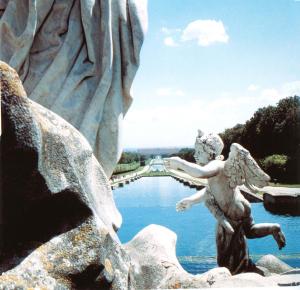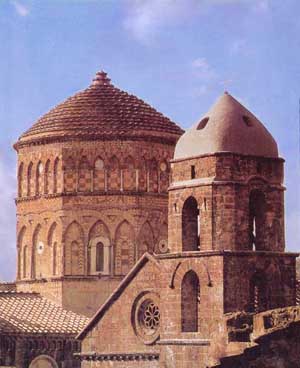|
|
Apartments in Florence, Perugia, Rome, Sorrento and Positano |




|
|
|
|
- You are in: Home » Campania » Caserta
VISIT CASERTA
« All the regions
THE ROYAL PALACE OF CASERTA

The monumental Palace of Caserta, created by the king Charles of Bourbon during the XVIII century, was built to be a new Versailles, a symbol of the greatness of the new kingdom. The architect of this incredible masterpiece was Luigi Vanvitelli. Charles of Bourbon decided to build that Royal Palace in Caserta because in 1742 the
British fleet threatened to bombard Naples to obtain the neutrality of the Kingdom of the two Sicilies in the war of succession for the throne of Austria. It would have been quite easy to shell Naples from the sea: that is the reason why the Bourbon king founded a new capital away from the coast.
Caserta became the new capital of the Kingdom of Naples. Its foundation stone was laid on 20 January 1752 in an official ceremony celebrating the 36th birthday of King Charles. Vanvitelli had presented his project the previous year, on 2 May 1751. Over the years, King Charles personally followed the works together with the Queen and they both were Vanvitelli’s inspirers, however without modifying the original design of the great architect. It was an
excellent ‚Äúunion of souls‚ÄĚ: evidence of this is given by Vanvitelli himself, in his periodic letters sent to his brother, where he always expressed his joy for the attention that the two Sovereigns paid to his work and for the good understanding that made the work progress quickly and with great profit.
In fact, after the Sovereign left Naples to ascend the throne of Madrid in 1759, things never went as
before and Vanvitelli always recalled the happy days of the ‚Äė50s, sometimes with
a bitter regret. The situation even worsened when Tanucci took control of the Kingdom and cut the money available to Vanvitelli: in the ‚Äė50s 2000 workers were employed in the construction, but in the ‚Äė60s their number was halved. Then in
1767 Vesuvius lent Vanvitelli a hand: after a violent eruption, the young King Ferdinand IV decided to move the Court from Portici to Caserta and therefore he
resumed his work in a more active way. But the conclusion of the works will take place only during the XIX century.
The Palace has been designed as a huge building with twin façades, one facing the parade ground, the other the gardens. The central dome and the statue of Charles
on the gable in the middle of the façade were present in the original design but were never realised. In total, the Palace has 1200 rooms, 1742 windows and a garden
3 km long. In 1762 the water from Maddaloni reached the Palace through the Caroline
aqueduct. A description of the Palace and its gardens is impossible here.
It is one of the most famous and loved architectural masterpieces in the world. We will limit ourselves to spend a few words on the most important and beautiful rooms. First of
all we could mention for their beauty the ‚ÄúRoyal Staircase‚ÄĚ and the Palatine Chapel (similar to that one in Versailles). The Chapel, in particular, is an
unadorned and vaulted room with columns and a high stylobate. It was inaugurated by the Mass of Christmas Eve in 1784, in presence of the King and all the Court. The chapel is dedicated to the Virgin Mary, whose image is painted on the apse. An important room is ‚ÄúThe room of Alexander‚ÄĚ where during the French domination (1806-1815) the throne of the viceroy Murat was. Very interesting in the same room are also two big paintings representing ‚ÄúThe abdication of Charles in favour of his son Ferdinand‚ÄĚ by Maldarelli and ‚ÄúCharles at the battle of Velletri‚ÄĚ by Camillo Guerra.
Another important room is obviously the Throne one, designed by the architect Genovesi in 1845 where the carved wooden throne lies and all around on the top of the walls 46 medallions represent the various kings of Naples over the centuries.
Worthy of note are also the ‚ÄúRooms of the Seasons‚ÄĚ, small and highly decorated rooms: in the room of ‚ÄúSpring‚ÄĚ, the King and Queen welcomed their most intimate guests and
Hackert embellished it with some splendid paintings of views of harbours.
Once crossed the three neoclassical rooms of the Palatine Library, we reach the Elliptic Room, all white washed, without decorations, destined to the Court
recreation: nowadays it houses the enchanting Bourbon Crib. Bourbon kings always
encouraged the ancient Neapolitan tradition of making Cribs and every Christmas a
huge crib was prepared in the Palace by expert artisans but also by the Princesses, who tailored the dresses of the shepherds. The hands, heads and feet of the statuettes were made of clay, whereas the body was made of straw and wire.
To conclude, no description can convey the beauty of the wonderful gardens and their enchanting statues, that can only be appreciated personally there. Only by visiting
this place we can realise the splendour of the Palace and the munificence of the Bourbons, makers of some of the most beautiful and largest Palaces in the world.
top
CASERTAVECCHIA

THE HISTORY OF CASERTAVECCHIA
The origin of ‚ÄúCasa Hirta‚ÄĚ dates back to 861. The village formerly belonged to the Longobards of the Principality of Capua, then it was given to Pandolf, Count of Capua. In the IX century, after the Saracens invaded and destroyed Capua and Galizia, the inhabitants of the plain felt the need to move to a safer place. The clergy did the same, but they definitively settled in Casa Hirta only about a century later. In 1062 Casertavecchia was invaded by Richard I of Aversa who started the Norman rule. It was in this century that bishop Rainulf decided to build the Cathedral (1110-1129).
In the 1153 the Cathedral was consecrated to the cult of the Archangel St. Michael. After the Norman rule, the village was subdued by the Swabians with Richard I of Lauro of the Sanseverino Family, who was Frederick II’s adviser. In 1310 the earldom was given to the De La Raths who kept it till the Spanish rule. With the arrival of tha Aragoneses, the village lost its importance as life began developing in the plain. The Seminary and the Bishop remained in Casertavecchia but later they moved to the plain as well. First they settled in Falciano, then, in 1842, they moved to Caserta.
After the Bourbons took the power in this area and after Vanvitelli was charged to build the Royal Palace, all the inhabitants of Casa Hirta left their village.
THE CATHEDRAL OF CASERTAVECCHIA
The square is enclosed by the Bishop‚Äôs Palace, the Seminary and by the Rectory which faces north and was built under Bishop Schinosi in 1600.. In the rectangular square there are 4 granite columns which represented the ‚ÄúPrivilegium Immunitatis‚ÄĚ.
The front of the Cathedral faces east. It shows different figures of symbolic and decorative animals which were typical of the Lombard Masters. At the bottom of the door-posts of the middle portal there is the representation of a mollusc and of a turtle which seem to invite mankind to salvation trough joining the Church. The epigraphs on the architraves of the 3 portals point out that the Cathedral was begun under Bishop Rainulf (1110-1129), carried on under Bishop Nicholas (1129-1137) and finished under Bishop John in 1153.
The Church-tower was built under Bishop Andrew 81 years later (1234) as we can read from the tablet on the left-side of the church. It is supported by a Gothic arch passageway over a narrow street. It is 32 m. high, it has 5 levels all adorned with a mullioned window. At the 4 level over the mullioned window there is a human figure holding a pigeon in his hand on the north side; there is a marble human head on the west side; there is another marble head on the south and a piperno tufaceous head on the east side. The 5th level has an octagonal plan and has circular small towers on its edges. In the past the church tower ended with a pyramid but it has been destroyed by a lightning.
The interior of the Cathedral is wonderfully simple and ancient. Two lines of 9 monolithic columns each, taken, together with their capitals, from various temples and monuments in the plain, look like the arms of a giant of faith and art. We wonder how they could carry them up here without our modern means of transport.
The monolithic Basin in the middle of the Chapel at the beginning of the right aisle, dating probably from the IV century, was used to administer baptism by immersion. On the pillar to the right of the arch leading to the Chapel there is a fresco representing St. Christopher. On the opposite wall, standing out of the traces of other disappeared frescoes, there is the figure of St. Michael, the Archangel weighing a man with a balance in his left hand. Both frescoes date most probably from the XIII century.
The Pulpit was built during the Baroque age by Bishop Diodato Gentile (1604-1616) by using fragments of the old ambos of Bishop Stabile (1208-1216). It is a wonderful work, indeed, thanks to its beautiful mosaics and sculptures.
The main Altar is modern; only the altar-frontal is quite old, being one of the fragments of the ancient ambos of Bishop Stabile, dating back to 1213. The old altar was replaced by a Baroque one in 1610, but even this one has been removed quite recently. The mosaic floor before the Main Altar, divided into 8 panels with animal figures, among which a Swabian eagle stands out, was made probably by order of the Emperor Frederick II, whose daughter Violante married our Count Riccardo. The Dome is one of the gems of the Romanesque architecture. It rests on a square structure, that, with pendentives in its corners, by doubling becomes an octagon. Then the octagon becomes a polygon with 16 sides. Lastly, it ends with an umbrella-shaped elliptic structure with 32 corners. The wooden Crucifix dominating the central apse below the dome, was made by an unknown artist and dates back to the XVI century. It presents three different expressions depending on the visitor’s viewpoint, on the right, before it, on the left. The most beautiful expression is that one a visitor perceives by looking from the left side.
top
|
|
|
|
|
|
| TOP DESTINATIONS
|
| Adria Coast, Aeolian Islands, Alessandria, Altopiano Delle Rocche, Amalfi Coast, Aosta, Assisi, Asti, Bari, Brescia, Capo Vaticano, Capri, Catanzaro, Chianti, Cilento, Cinque Terre, Coast Of Marche, Conero Coast, Dolomites, Egadi Islands, Elba, Florence, Garda Lake, Gargano, Ischia, Italian Riviera, Lake Como , Langhe Piedmont, Lecce, Lucca, Lunigiana, Macerata, Mantova, Maremma Tuscany, Monferrato, Montepulciano, Naples, Perugia, Pesaro Urbino, Pisa, Pistoia, Positano, Prato, Procida, Riviera Of Palms, Rome, Salento Coast, Salerno, San Gimignano, Sardinia, Sicily, Siena, Sorrento, Terni, Tiber Valley Of Tuscany, Treviso, Turin, Val Gandino, Veneto, Venice, Viterbo |
|
|






